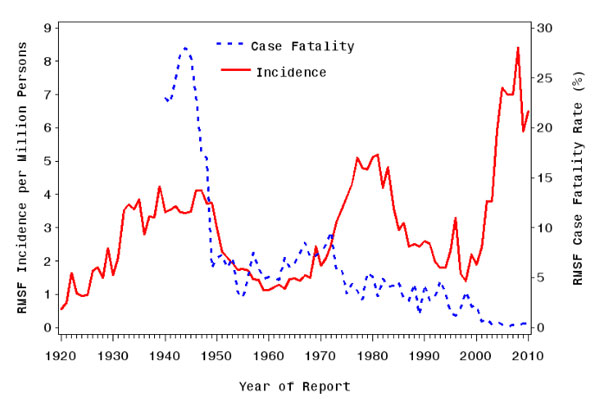Rocky mountain spotted fever: Difference between revisions
No edit summary |
|||
| Line 34: | Line 34: | ||
[[Image:rrgraph.JPEG|thumb|600px|left|Graph describing incidence of RMSF in North America over time, comparing fatality and incidence changes.[http://www.cdc.gov/rmsf/stats/index.html]]] | [[Image:rrgraph.JPEG|thumb|600px|left|Graph describing incidence of RMSF in North America over time, comparing fatality and incidence changes.[http://www.cdc.gov/rmsf/stats/index.html]]] | ||
===Socioeconomic Effects=== | ===Socioeconomic Effects=== | ||
===Demographics=== | ===Demographics=== | ||
The nature of tick bourne disease is that cultures and demographics that spend more time in the outdoors are most prominently effected. In north and south America, native groups such as American Indian reservations and other tribes are the most likely to face high numbers of tick born illness including Rocky Mountain Spotted Fever, which occurs at a rate of 37.4 case per million in American Indian populations vs. 21.6 cases per million in the general Oklahoma population. [http://www.researchgate.net/publication/12095919_Incidence_of_Rocky_Mountain_spotted_fever_among_American_Indians_in_Oklahoma] | |||
===Prevention=== | ===Prevention=== | ||
Revision as of 14:05, 27 July 2015


Classification
Taxonomy
Bacteria; Proteobacteria; Alpha Proteobacteria; Rickettsiales; Rickettsiaceae; Spotted fever group
|
NCBI: Taxonomy |
Rickettsia rickettsii
Description
Rocky Mountain Spotted Fever is the disease associated with infection by Rickettsia rickettsii. R. rickettsii is a small rod shaped bacterium that lives within the cytoplasm of a host cell. It requires an arthropod for transmission to a human host typically through bite and is known to be caused primarily by tick bites. Rocky Mountain Spotted Fever can also infect other mammals, particularly dogs. The disease is characterized by a skin rash called purpura or petechiae, though the rash can occur up to five days after the onset of the other symptoms including fever, nausea, vomiting, headache, muscle pain, and depression.[6]
Pathology


Symptoms
Symptoms of RMSF include rash, fever, depression, nausea, vomiting, and muscle pains. The rash appears in 90% of patients, though fever and other symptoms often proceed the rash by 2-5 days. After the 6th day of infection, a petechial (red to purple spotted rash) occurs in 35-60% of patients and is indicative of severe disease progression. RMSF can be fatal within 8 days if not properly treated. [7]
Treatment
The primary treatment for RMSF in adults is 100 mg of the antibiotic Doxycycline every 12 hours for 7-14 days. The standard treatment for children is 45kg of Doxycycline every 12 hours for 7-14 days. Doxycycline is the treatment of choice because it is associated with the lowest fatatily of treatments used for RMSF. Alternate treatments include other antibiotics, but are not recommended by the CDC due to higher risk of patient death. [8]
Transmission
Rocky Mountain Spotted Fever is most often spread through the bite of a tick. The most common ticks to carry Ricketsia ricketsii are the American dog tick (Dermacentor variabilis), Rocky Mountain wood tick (Dermacentor andersoni), and brown dog tick (Rhipicephalus sanguineus). An infected tick can infect multiple hosts with Ricketsia ricketsii. [9]
Damage Response Framework
Epidemiology

Socioeconomic Effects
Demographics
The nature of tick bourne disease is that cultures and demographics that spend more time in the outdoors are most prominently effected. In north and south America, native groups such as American Indian reservations and other tribes are the most likely to face high numbers of tick born illness including Rocky Mountain Spotted Fever, which occurs at a rate of 37.4 case per million in American Indian populations vs. 21.6 cases per million in the general Oklahoma population. [10]
Prevention
Biotechnology
Bioterrorism
Page in progress by Cassandra Long, student of Tyrrell Conway
